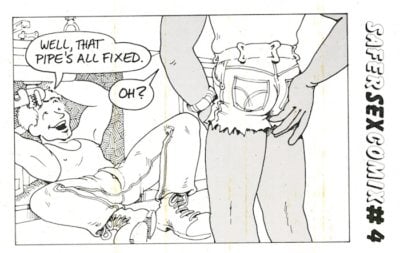
Gran Fury’s iconic image “Kissing Doesn’t Kill: Greed and Indifference Do” is one of nearly 100 queer history items included in the ONE Archives “Lost & Found” exhibit. Photo: ONE Poster Collection at the ONE National Gay & Lesbian Archives at the USC Libraries
WEST HOLLYWOOD — A new queer history exhibit that spotlights 30 years of safer-sex and harm-reduction activism in the fight against HIV and AIDS will open in West Hollywood at the newly renovated ONE Gallery, the exhibit space for the ONE Archives Foundation.

This 1986 cover of “Safer Sex Comix #4” from the Gay Men’s Health Crisis is one of nearly 100 queer history items on display in “Lost & Found.” Photo: AIDS History Project Collection at the ONE National Gay & Lesbian Archives at the USC Libraries.
The free exhibit, “Lost & Found: (Safer Sex Activism),” will open Saturday and close June 24.
It shows how activists, during the 1980s and 90s when the AIDS epidemic reached crisis proportions, attempted to educate the public about the disease and to break the perceptions that demonized gay men and intravenous drug users and blamed them for AIDS.
“Rather than stigmatize sexuality, these educational projects were sex positive, and the artists and activists used various media to reach communities, such as people of color, that had been underserved,” ONE Archives curator David Evans Frantz said in an interview. “There was a queer intersectional dialogue. It was profound for the time.”
Frantz and indie curator Hannah Grossman collaborated on the exhibit, which includes almost 100 iconic, rare, and never-before-seen items: posters, comics, brochures, videos, PSAs, safer sex and clean needle kits, among other material that was sourced from the ONE National Gay & Lesbian Archives at USC, the world’s largest collection of queer history.
New HIV prevention services available for black community in Los Angeles
ONE ARCHIVES’ MATERIAL
One of the most iconic images is Gran Fury’s “Kissing Doesn’t Kill: Greed and Indifference Do” campaign, which shows three couples kissing under the “Kissing Doesn’t Kill” slogan.
Other items on display:
- Posters from the 1990s made by the Oakland-based group AIDS Project of the East Bay, including a poster featuring poet Essex Hemphill
- Needle exchange kits from Clean Needles Now, a Los Angeles grassroots organization founded in the 1990s
- Explicit posters produced by Color Coded, a collaboration between Gay Men of Color Consortium, Los Angeles and the Los Angeles Center for Photographic Studies
- Erotic, safer-sex videos intended to reach an at-risk audiences produced in 1989-1990 by The Gay Men’s Health Crisis, founded in 1982 and then the largest AIDS services organization
“Lost & Found” links the historical items to the ongoing HIV-AIDS crisis through contemporary artist and activist projects like the Play Smart condom trading card packets, produced by the New York-based organization Visual AIDS, that features contemporary artists such as Kia Labejia, L.J. Roberts, and Ben Cuevas.
Black History Month: Sir Lady Java was a transgender trailblazer who challenged police harassment
HIV URGENCY
Neal Baer, M.D. and a consultant on “Lost & Found,” wants to draw attention to the dire HIV infection rates still prevalent in Los Angeles County, specially within communities of color.
For example, data from the Los Angeles County Health Department shows alarming HIV infection rates for men who have sex with men:
- 2 out of 5 black men
- 1 in 5 Latino men
- 1 in 10 white men
“For decades, the prescription for life was tied to two lines of defense, abstinence or condoms,” Baer said in a statement. “Even today, with significant health advances to prolong life and prevent infection with medication, many HIV positive people are not in treatment, and young people of color are still being infected at high rates.
“This show,” he said, “puts the microscope on historical documents and contemporary efforts that illuminate an urgency that still exists.”
